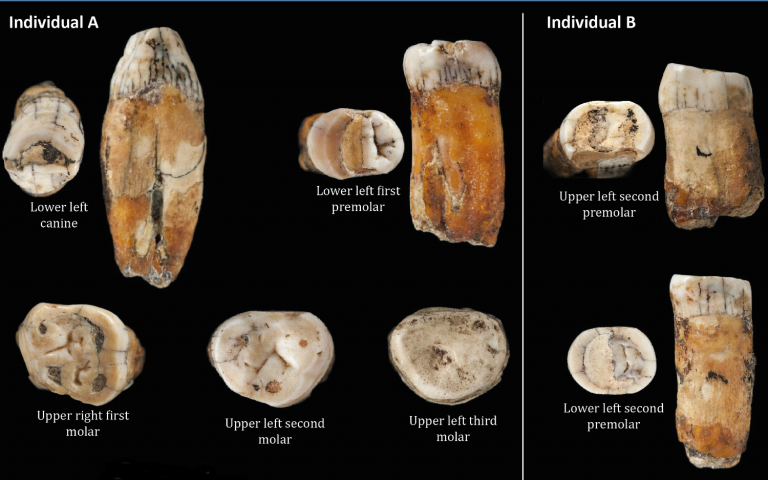Ancient teeth suggest breeding between Neanderthals and modern humans
1 February 2021
New analysis of 13 ancient teeth may have revealed a hybrid population made from both Neanderthals and modern humans, according to UCL archaeologists.

First found in 1910 and 1911 in La Cotte de St Brelade in Jersey, the teeth were recently re-examined when further excavations began at the site in 2019, led by Dr Matt Pope (UCL Institute of Archaeology).
Research published in the Journal of Human Evolution, co-authored by Dr Pope with the Natural History Museum, Jersey Heritage, the University of Kent and others, shows that rather than belonging to one Neanderthal, the teeth came from two different ancient human individuals.
Intriguingly, while all the teeth have clear Neanderthal characteristics, some of them lack certain expected features, and their shape is more typical of modern humans - Homo sapiens - suggesting dual ancestry.
Dr Matt Pope, who is leading the Jersey Heritage funded excavations for UCL’s Institute of Archaeology, said: “This work offers us a glimpse of a new and intriguing population of Neanderthal people and opens the door to a new phase of discovery at the site.
"We will now work with Jersey Heritage to recover finds and fossils from La Cotte de St Brelade, undertake a programme analysis with our scientific colleagues, and put in place engineering to protect this very vulnerable site for the future. It will be a mammoth project and one to watch for those fascinated by our closest evolutionary relatives.”
Following the original discovery of the teeth, excavations at the same site continued until 1920 and recovered over 20,000 stone tools assigned to the Middle Palaeolithic, a technology associated with the Neanderthals in Europe.
Recent dating work funded by the Natural Environment Research Council (NERC) on nearby cave deposits indicated that the teeth are likely to be less than 48,000 years old. This suggests they could represent some of the youngest Neanderthal remains ever found, with this species believed to have disappeared around 40,000 years ago.
Research Leader Professor Chris Stringer, from the Natural History Museum, said: “Given that modern humans overlapped with Neanderthals in some parts of Europe after 45,000 years ago, the unusual features of these La Cotte individuals suggest that they could have had a dual Neanderthal-modern human ancestry. This idea of a hybrid population could be tested by the recovery of ancient DNA from the teeth, something that is now under investigation.”
The teeth are on permanent display at Jersey Museum & Art Gallery. However, anyone wanting to take a closer look at them can see 3D X-ray images of all the La Cotte de St. Brelade specimens on The Human Fossil Record, an online archive of digital media and information.
Professor Matt Skinner, University of Kent, said: “Through our collaboration with Jersey Heritage, anyone can examine these fossils virtually, but also download surface models and 3D print them if they want to have their own high-resolution copies for teaching or just to put them on their mantlepiece. They are the next best thing to the fossils themselves.”
- Research paper in the Journal of Human Evolution
- Dr Matthew Pope’s academic profile
- UCL Institute of Archaeology
- Jersey Heritage
- The Natural History Museum
- UKRI National Environment Research Council
- The Human Fossil Record
Image
Some of the Neanderthal teeth recovered from La Cotte de St Brelade from Société Jersiaise Photographic Archive
Media Contact
Jane Bolger
Tel: +44 (0)20 3108 9040
Email: j.bolger [at] ucl.ac.uk
 Close
Close

